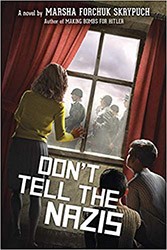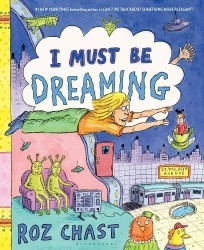In this inventive graphic novel set in France during World War II, young Rachel Cohen is forced to develop deceptive strategies in order to survive the Nazi regime. Assuming a new identity as a Christian, she becomes Catherine Colin; however, she manages to preserve her authentic self — a photographer intent upon recording the dangerous and inspiring world around her. Through the lens of her passionate commitment to this process, she saves both her Jewish self and pieces of history threatened with destruction. Based partially on the experience of Billet’s mother, this chronicle of resilience paints young readers a vivid picture of a harrowing time. Originally published as a novel without illustrations, this new graphic version of Catherine’s story is enhanced by the powerful element of Fauvel’s expressive pictures.
The book begins at the Sèvres Children’s Home, an educationally progressive institution not far from Paris. Rachel is terrified for her missing parents, but after the headmistress’ husband generously gives her a Rolleiflex camera, she finds a new source of courage: “I bury my anger and focus on the pictures.” Scenes in the darkroom are bathed in a magical red, setting them apart from the dominant blue and gray of other sequences. Taking pictures forces Rachel to define the people and events around her, but also her own interior being. As the Nazis and their French collaborators turned every Jew into an enemy, she meditates on what it means that “I’m Jewish, but I never really believed in God.” At the same time, her artistic gift and its meaning become clearer to her as she discovers an almost spiritual component. Excited at having finally composed the perfect “shot” of a photograph, she concedes the mysterious component of this triumph: “Unless it’s the shot that found me.” Throughout the novel, Billet’s concise and understated language works well with Fauvel’s images, enabling both author and illustrator to take risks in exploring difficult emotions.
Rachel learns that she will have to leave Sèvres to find refuge in a convent, where she will become a kind of photographic negative of herself as Catherine Colin. Rachel is deeply disturbed at this loss, fearing that her parents will never find her “if I am no longer me.” Yet she finds the strength to transform every betrayal — eating pork or confessing her sins to a priest — into a secret form of resistance. Fauvel’s depiction of faces is subtle; readers see a full range of human experience in Rachel’s sadly downturned eyes during Catholic rituals and in her look of determination as she participates in Resistance activities. In one shocking image which highlights the commitment of the nuns protecting these hidden children, Catherine is slapped across the face by one of these brave women. Such an obvious error would reveal Catherine as a Jew and only a harsh physical reminder would prevent her from repeating the mistake.
When the convent becomes unsafe, Catherine finds refuge with a farmer’s family. The constant tension of gauging who is a friend and who an enemy pervades her whole life. Photography remains her way of imposing order on this chaotic world; she is able to grant meaning to people and events through rendering them as photographic works of art. Catherine is also transformed from an insecure young girl to a mentor, teaching and reassuring other Jewish children.
Billet and Fauvel chronicle her parallel developments as a woman and as an artist. After Paris is liberated, she returns to Sèvres. In a dramatic two-page spread, she works in the darkroom where her original initiation into photography began, producing a collage of black and white photos; the photographs are a stunning and permanent record of Catherine’s survival and of her maturity as an artist. This remarkable graphic novel, about one Jewish woman’s journey toward self-definition, is as sharply composed as the snapshots she takes with her Rolleiflex.
Catherine’s War is highly recommended and includes a map, photographs, “A Note to the Reader,” and excellent background material in the format of questions and answers.
Emily Schneider writes about literature, feminism, and culture for Tablet, The Forward, The Horn Book, and other publications, and writes about children’s books on her blog. She has a Ph.D. in Romance Languages and Literatures.




